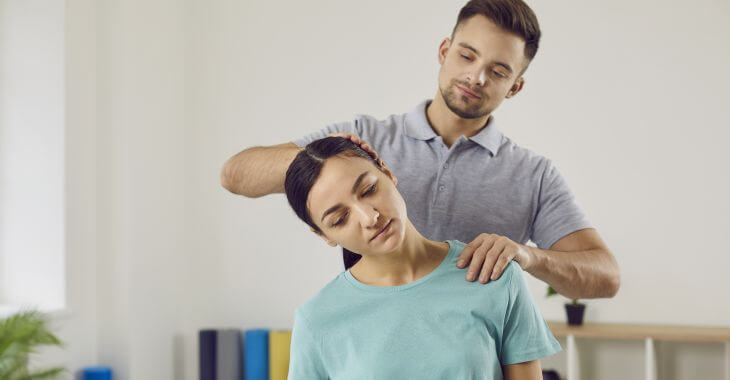Levator Scapulae Stretch: How to Loosen a Tight Neck

A tight neck can be an uncomfortable and painful experience, often accompanied by stiffness, restricted range of motion, and tension headaches. One possible cause of tightness and pain in the neck is a strain of the levator scapulae muscles – exercises and a levator scapulae stretch can relieve a tight neck.
Understanding Neck Anatomy
The neck is a complex structure composed of muscles, bones, and ligaments, supporting the head’s weight while allowing for a wide range of motion. Key anatomical features involved in neck movement and potential tightness include:
- Cervical Vertebrae: The neck consists of seven cervical vertebrae (C1 to C7), which form the spine’s uppermost portion. These vertebrae are responsible for both neck stability and flexibility.
- Neck Muscles: The neck is surrounded by several muscle groups, including the trapezius, sternocleidomastoid (SCM), scalene muscles, and the levator scapulae. These muscles work together to control head movement and maintain posture.
- Nerves and Blood Vessels: Important nerves and blood vessels, such as the vertebral arteries, pass through the neck, requiring proper alignment and flexibility to avoid compression or impingement.
These elements work together to provide neck function, but they can be injured by trauma to the neck, repetitive movements and degenerative disease.
What Causes Tightness in the Levator Scapulae?
Neck tightness can have various causes, often stemming from lifestyle factors and musculoskeletal issues. Many of these factors can affect the levator scapulae muscles, as well as other components within the neck like the rhomboid muscles. Some include:
- Poor Posture: Prolonged periods of poor posture, especially when using computers or mobile devices, can strain neck muscles and contribute to tightness.
- Stress and Tension: Stress can manifest physically, leading to muscle tension in the neck and shoulders.
- Overuse: Repetitive movements or overuse of neck muscles, common in certain professions, can result in chronic tightness.
- Inactivity: A sedentary lifestyle can weaken neck muscles, making them more susceptible to tightness and discomfort.
- Muscle Imbalances: Muscle imbalances in the neck and upper back, such as overdeveloped trapezius muscles and weak rhomboids, can lead to chronic tightness.
Levator Scapulae Exercises and Stretches
A levator scapulae stretch is one of the most effective scapulae levator and rhomboid muscles pain relief exercises. This stretch helps to release tension and improve flexibility in the neck and upper back. Here’s how to perform it:
Step 1: Proper Setup
- Stand or sit up straight with your shoulders relaxed.
- Keep your feet shoulder-width apart for stability.
Step 2: Hand Placement
- Raise your right arm straight in front of you at shoulder level.
- Bend your right elbow at a 90-degree angle, keeping your palm facing up (as if you were holding a tray).
Step 3: Stretching
- Use your left hand to gently grasp your right elbow.
- Pull your right elbow across your chest toward your left shoulder.
Step 4: Maintain Proper Posture
- Ensure that your shoulders remain down and relaxed throughout the stretch.
- Keep your head in a neutral position, avoiding tilting it to the side.
Step 5: Hold and Breathe
- Hold the stretch for 15-30 seconds, feeling a gentle pull in the right side of your neck and upper back.
- Breathe deeply and slowly throughout the stretch, allowing your muscles to relax.
Step 6: Repeat on the Other Side
- Release the stretch and return your right arm to the starting position.
- Perform the levator scapulae stretch on the left side by raising your left arm, bending your left elbow, and using your right hand to gently pull your left elbow across your chest toward your right shoulder.
Step 7: Frequency and Sets
- Perform the levator scapula exercises on both sides for 2-3 repetitions.
- You can do this stretch multiple times a day, especially if you have a sedentary job or experience neck tightness frequently.
Tips for a Successful Stretch
Levator scapulae and rhomboid pain relief exercises like a scapula stretch should be carefully performed to avoid further injury. Some tips for a successful stretch of the neck muscles include:
- Avoid forcing the stretch or causing pain. It should be gentle and comfortable.
- Focus on your breathing; deep breaths help relax the muscles further.
- Perform the stretch on both sides to maintain balanced flexibility.
- Incorporate regular stretching into your routine to prevent future neck tightness.
In addition to the levator scapulae stretch, consider these lifestyle changes that can alleviate neck tightness. This includes creating an ergonomic workspace, incorporating levator scapulae exercises in your fitness routine and taking routine breaks from repetitive neck movements.
If neck tightness persists or is accompanied by pain or other symptoms, consult a doctor or orthopedic specialist for evaluation and guidance.

The levator scapulae stretch is a valuable tool for loosening a tight neck and improving overall neck flexibility. When performed correctly and regularly, this stretch can provide relief from tension and discomfort, promoting better posture and reducing the risk of future neck issues.
The information provided on this website, including text, graphics, images, and other materials, is intended solely for informational purposes and should not be used as a substitute for professional medical advice, diagnosis, or treatment.


)